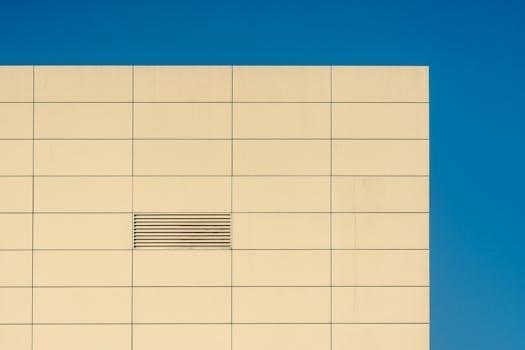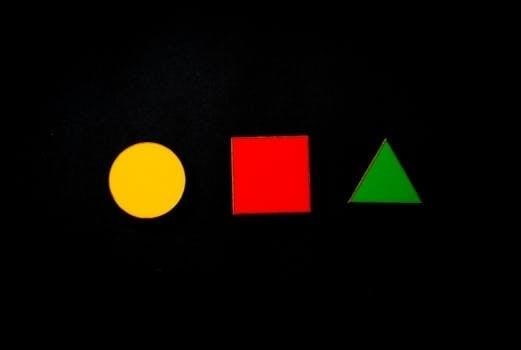Basic Geometry Questions and Answers PDF⁚ An Overview
Geometry is explored through questions and answers in PDF format, which provide practice problems, detailed solutions, and essential geometric concepts․ These resources are essential for students seeking to improve their skills in basic geometry․

Fundamental Geometric Concepts
Basic geometry involves understanding fundamental concepts like points, lines, and planes․ These elements form the building blocks for more complex geometric figures․ A solid foundation in these concepts is essential for solving geometry problems․
Points, Lines, and Planes
In geometry, a point is a location, a line is defined by two points, and a plane extends infinitely in two dimensions․ Understanding the relationships between points, lines, and planes is crucial for solving geometric problems․ These basic elements are the foundation upon which all geometric shapes and figures are built․ Mastering these concepts is essential for further studies․
Angles and Their Properties
Angles are formed by two rays sharing a common endpoint, known as the vertex․ They are measured in degrees․ Different types of angles include acute, obtuse, right, and straight angles, each with distinct properties․ Understanding angle relationships, such as complementary, supplementary, and vertical angles, is essential for solving geometry problems․ These relationships help in determining unknown angles and proving geometric theorems․
Triangles⁚ Properties and Problem Solving
Triangles are fundamental geometric shapes with three sides and three angles․ Understanding their properties, such as angle sums and side relationships, is crucial for effective problem-solving in geometry․
Types of Triangles
Triangles are classified based on their angles and sides․ Equilateral triangles have three equal sides and three equal angles․ Isosceles triangles have at least two equal sides and two equal angles․ Scalene triangles have no equal sides and no equal angles․ Right triangles have one angle measuring 90 degrees․ Acute triangles have all angles measuring less than 90 degrees․ Obtuse triangles have one angle measuring greater than 90 degrees․ Understanding these distinctions is crucial for solving geometric problems․
Triangle Angle Sum Theorem
The Triangle Angle Sum Theorem states that the sum of the interior angles of any triangle is always 180 degrees․ This theorem is fundamental in geometry and is used to find unknown angles within triangles when other angles are known․ For example, if two angles of a triangle measure 60 and 80 degrees, the third angle can be found by subtracting their sum (140 degrees) from 180 degrees, resulting in 40 degrees․ This theorem applies to all types of triangles, regardless of their shape or size․
Quadrilaterals⁚ Exploring Shapes and Solutions
Quadrilaterals, four-sided polygons, offer rich geometric problems․ Solving these problems involves understanding their specific properties․ This section explores types of quadrilaterals, including parallelograms, rectangles, squares, and trapezoids․ Solutions often require applying theorems related to angles and sides․
Parallelograms, Rectangles, Squares, and Trapezoids
Parallelograms have opposite sides parallel and equal, rectangles have four right angles, squares combine both properties, and trapezoids have at least one pair of parallel sides․ Understanding these properties is crucial for solving geometry problems․ Questions often involve finding areas, perimeters, or missing angles using theorems․ For example, the area of a parallelogram is base times height, while the area of a trapezoid involves averaging the lengths of the parallel sides․ These shapes provide fundamental geometry skills and are essential for spatial reasoning․

Circles⁚ Essential Theorems and Calculations
Circles involve calculations of area and circumference and theorems related to inscribed angles and tangents․ Understanding these concepts is essential for solving geometry problems․ The PDF resource provides clear explanations and practice questions for mastering circle geometry․
Area and Circumference
Calculating the area and circumference of circles are fundamental skills in geometry․ The area, determined by πr², quantifies the space enclosed within the circle․ Circumference, calculated as 2πr, measures the distance around the circle․ Problems often involve finding these values given the radius or diameter, or vice versa․ Understanding the relationship between radius, diameter, area, and circumference is essential․ Practice questions and step-by-step solutions in the PDF help reinforce these concepts, aiding in problem-solving proficiency․ Mastery of these calculations is crucial for more advanced geometry topics․
Inscribed Angles and Tangents
Inscribed angles and tangents are crucial concepts when studying circles․ An inscribed angle is formed by two chords in a circle that have a common endpoint, and its measure is half the measure of the intercepted arc․ Tangents are lines that touch the circle at only one point, and the angle between a tangent and a radius at the point of tangency is always 90 degrees․ Problems involving these concepts often require applying theorems related to angles and arcs․ Mastering these principles is vital for solving complex geometric problems․
Area and Volume Calculations
Calculating area and volume is fundamental in geometry․ Area refers to the 2D space within a shape, while volume measures 3D space․ Understanding formulas for various shapes is essential for solving related problems efficiently․
Area of 2D Shapes
Calculating the area of two-dimensional shapes is a core concept in geometry, involving various formulas for different figures․ For rectangles, the area is found by multiplying length and width․ Triangles use the formula 1/2 * base * height․ Circles rely on πr², where ‘r’ is the radius․ Parallelograms involve multiplying the base by the height, while trapezoids use the formula 1/2 * (base1 + base2) * height․ These calculations are essential for practical problems․
Volume of 3D Shapes
Determining the volume of three-dimensional shapes is a fundamental aspect of geometry․ Cubes use the formula side³, while rectangular prisms are calculated using length * width * height․ Spheres involve (4/3)πr³, where ‘r’ is the radius; Cylinders use πr²h, with ‘h’ representing height․ Cones are calculated using (1/3)πr²h, and pyramids use (1/3) * base area * height․ Understanding these formulas is essential for solving problems related to space and capacity․

Coordinate Geometry Basics
Coordinate geometry integrates algebra and geometry, using a coordinate plane to represent geometric shapes․ Key concepts include distance between points, finding the midpoint of a line segment, and analyzing lines and curves through algebraic equations․
Distance Formula
The distance formula is a fundamental tool in coordinate geometry, used to calculate the distance between two points in a coordinate plane․ Given two points, (x₁, y₁) and (x₂, y₂), the distance, d, is found using the formula⁚ d = √((x₂ ⎻ x₁)² + (y₂ — y₁)²) ․ This formula applies the Pythagorean theorem․ It calculates the length of the hypotenuse of a right triangle formed by the horizontal and vertical differences between two points․ The distance formula is essential for various geometric problems․
Slope and Equations of Lines
The slope of a line measures its steepness and direction, calculated as the ratio of the vertical change (rise) to the horizontal change (run) between two points․ The slope formula is m = (y₂, y₁) / (x₂ ⎻ x₁)․ Equations of lines can be expressed in various forms, including slope-intercept form (y = mx + b), point-slope form (y — y₁ = m(x ⎻ x₁)), and standard form (Ax + By = C)․ Understanding slope and line equations is crucial for solving problems related to parallel and perpendicular lines․

Proofs in Geometry
Geometric proofs involve using logical reasoning and geometric theorems to demonstrate the truth of statements․ These proofs are structured arguments, often using two-column formats, and rely on axioms, postulates, and previously proven theorems for justification․
Basic Proof Techniques
Basic proof techniques in geometry include direct proofs, indirect proofs (proof by contradiction), and mathematical induction․ Direct proofs start with given information and use logical steps to arrive at the desired conclusion․ Indirect proofs assume the negation of what needs proving, demonstrating a contradiction, therefore affirming the original statement․ Understanding these techniques is essential for solving geometry problems and grasping fundamental geometric principles․ Mastering proof techniques enhances problem-solving skills and deepens understanding․
